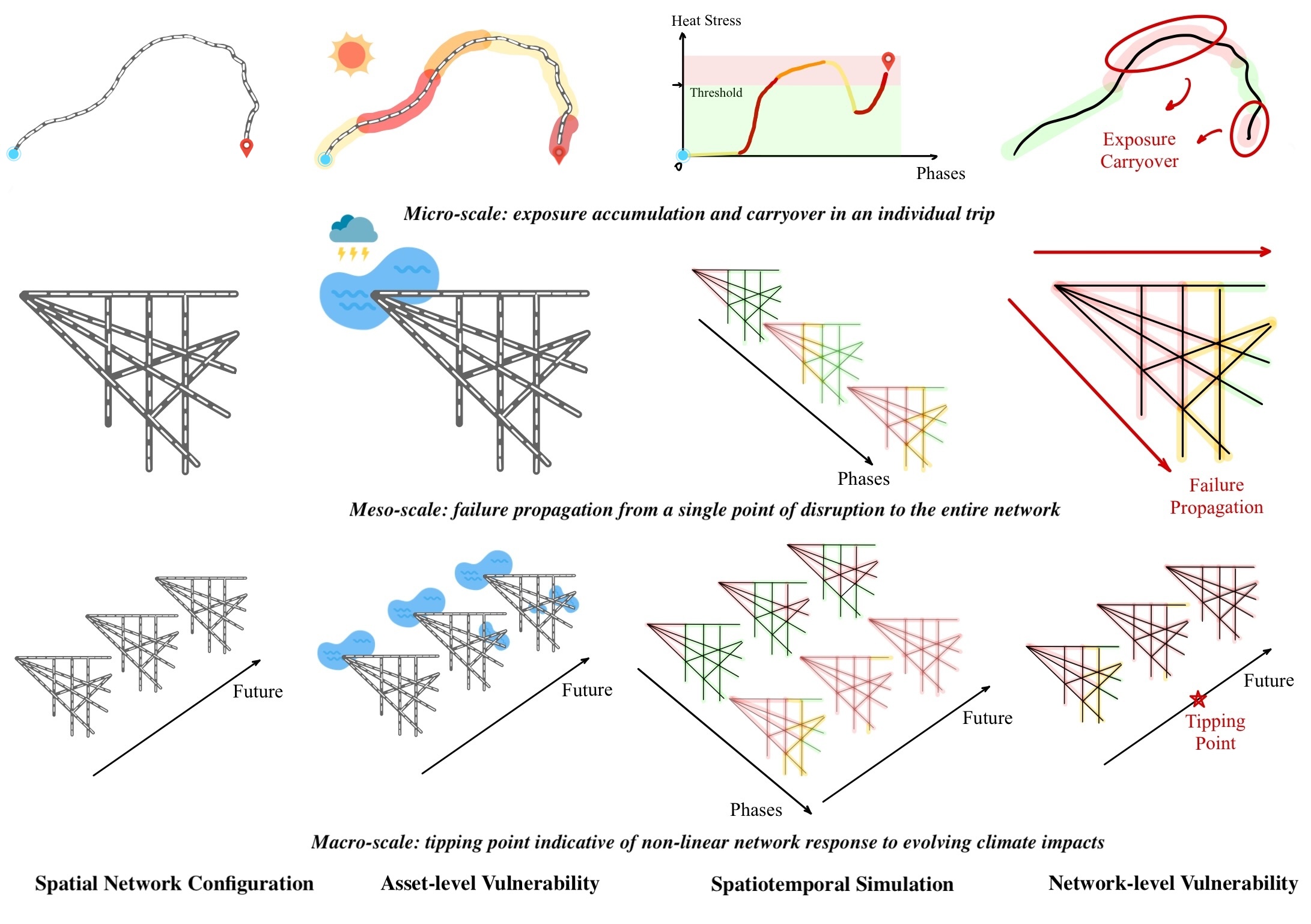Climate Resilience
Modeling cumulative exposure, cascading failure, and tipping points across scales to build more adaptive and resilient infrastructure.
Network-Level Resilience Across Scales
Despite growing interest in transportation resilience, most existing approaches focus on isolated infrastructure elements and overlook broader network dynamics. Our research addresses this gap by examining how extreme climate conditions influence multimodal transportation systems across multiple spatial and temporal scales.
Micro- to Macro-Scale Framework
Micro-scale: We quantify cumulative exposure to heat throughout individual trips using spatiotemporal models aligned with CDC and NWS health thresholds. This work reveals how small, localized exposures compound to create significant downstream health risks.
Meso-scale: We integrate flood hazard models with dynamic traffic assignment to simulate disruption propagation across a statewide road network. The results show how localized failures cascade into broader systemic breakdowns, guiding mitigation and bottleneck prevention strategies.
Macro-scale: Using high-performance computing, we simulate long-term climate scenarios and identify critical tipping points—thresholds at which service levels collapse nonlinearly. This modeling supports proactive policy interventions and infrastructure redesign under future climate uncertainty.

Ongoing and Future Work
We are now advancing this research by developing predictive resilience models that incorporate real-time sensor data and machine learning. These AI-enhanced systems will adapt to changing conditions and detect early warning signals to guide emergency evacuations, infrastructure investment, and operational decisions. By capturing dynamic, nonlinear responses at the network level, we aim to provide agencies with practical tools to prevent cascading failures and ensure long-term resilience.
Join Us
If you're a prospective student interested in pursuing research related to this topic, please visit this page for the latest updates on graduate opportunities. When completing your application, be sure to type "[Climate Resilience]" in response to the question: "If there are any special circumstances that you'd like me to know about, please list them here." (If there are actual circumstances to share, feel free to elaborate after the square brackets).
Related Publications
- Fan, H., Miller, R., & Huntsinger, L. (2023). Climate change impacts on North Carolina roadway system in 2050: A systemic perspective on risk interactions and failure propagation. Sustainable Cities and Society, 99, 104822. https://doi.org/10.1016/j.scs.2023.104822
- Fan, H., Lu, H., Lyu, G., Guin, A., & Guensler, R. (2024). A framework for assessing cumulative exposure to extreme temperatures during transit trip. arXiv preprint, arXiv:2408.04081.
- Fan, H., Lyu, G., Lu, H., Guin, A., & Guensler, R. (2025). Transit rider heat stress and health: potential impacts of current and future extreme heat exposure in Atlanta, GA. Environmental Research Letters, 20(5), 054055. https://doi.org/10.1016/j.agrformet.2018.11.027.
- Fan, H. (2024). Network-level modeling of transit riders and pedestrians’ thermal comfort. Georgia Institute of Technology, Theses and Dissertations. https://hdl.handle.net/1853/76890.
